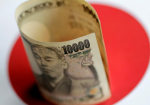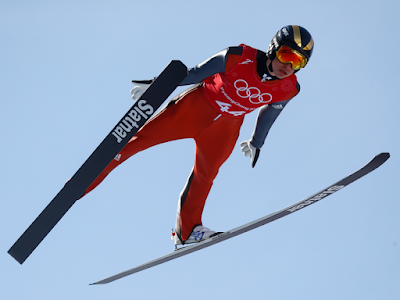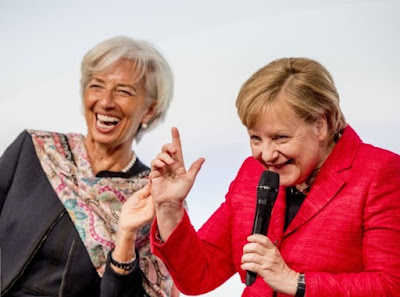Overview: The US dollar is trading with a bit of heavier bias against most of the major currencies as the focus turns to today's FOMC meeting, where a clear consensus has emerged in favor of faster tapering and a dot plot pointing to a steeper pace rate hikes. Emerging market currencies led by Turkey and South Africa are mostly lower. The JP Morgan Emerging Market Currency Index is lower for the third straight session. The US 10-year Treasury yield is flat, near 1.44%, while European yields are mostly a little higher. The US two-year yield is flat around 66 bp, while the 2-year Gilt yield jumped around 5 bp after higher than expected CPI. New US sanctions against Chinese companies took a toll in Chinese and Hong Kong indices, while Japan, South Korea, and
Topics:
Marc Chandler considers the following as important: 4.) Marc to Market, 4) FX Trends, Bank of England, Canada, China, ECB, Featured, FOMC, Japan, Mexico, newsletter, U.K., USD
This could be interesting, too:
Nachrichten Ticker - www.finanzen.ch writes Die Performance der Kryptowährungen in KW 9: Das hat sich bei Bitcoin, Ether & Co. getan
Nachrichten Ticker - www.finanzen.ch writes Wer verbirgt sich hinter der Ethereum-Technologie?
Martin Hartmann writes Eine Analyse nach den Lehren von Milton Friedman
Marc Chandler writes March 2025 Monthly
Overview: The US dollar is trading with a bit of heavier bias against most of the major currencies as the focus turns to today's FOMC meeting, where a clear consensus has emerged in favor of faster tapering and a dot plot pointing to a steeper pace rate hikes. Emerging market currencies led by Turkey and South Africa are mostly lower. The JP Morgan Emerging Market Currency Index is lower for the third straight session. The US 10-year Treasury yield is flat, near 1.44%, while European yields are mostly a little higher. The US two-year yield is flat around 66 bp, while the 2-year Gilt yield jumped around 5 bp after higher than expected CPI. New US sanctions against Chinese companies took a toll in Chinese and Hong Kong indices, while Japan, South Korea, and Taiwan posted modest gains. Europe's Stoxx 600 is snapping a five-day slide led by information technology, real estate, and utilities. US futures indices have edged higher. Gold fell by almost $16 yesterday, its biggest decline in about 2 1/2 weeks. It is in a $3-$4 range on either side of $1770. January WTI is softer and straddling the $70 level. US natgas is up around 1.8% today after falling about 4.5% in the past two sessions. On the other hand, European gas (Dutch) is snapping a three-day advance of more than 26%. Iron ore has extended yesterday's 2.2% retreat, while copper extends its swoon for the fifth consecutive session. It is setting new two-month lows today.
Asia Pacific:
China's November data will bolster expectations that officials will take more action to support the economy. First, we note that the sales price of newly constructed commercial, residential buildings in 70 major cities has slowed since May and has been falling for three months through November. Second, retail sales, fixed-asset investment, and property investment were weaker than expected. Third, surveyed unemployment unexpectedly edged up to 5.0% from 4.9%. Perhaps encouraged by new government actions, industrial output was the main exception to the soft reports. It accelerated to 3.8% year-over-year from 3.5%. Separately, the US has sanctioned several more Chinese companies, including SMIC and a few companies involved with drones and surveillance of Uyghur. Also, the US House of Representatives approved legislation yesterday that shift the burden on goods from Xingjiang. The goods are banned unless one can demonstrate that forced labor was not used.
Japan's tertiary industry index rose 1.5% in October. It is the first back-to-back gain this year and underscores the recovery in Japan's service sector. After a slow start, Japan's vaccination takeup has surpassed the US and many European countries. Japan reports its November trade balance tomorrow. It typically deteriorates from October, and the pattern is seen intact. Separately, Prime Minister Kishida expressed sympathy for re-writing the rules about share buybacks.
The greenback has been trapped in less than a 20-pip range so far today below JPY113.80. The 20-day moving average, which it has not closed above this month, is found slightly above the session high. There is an option for $1.4 bln at JPY113.75 that expires today and another for $1.1 bln at JPY114.20. The Australian dollar is firm above $0.7100. First thing tomorrow, Australia will see the flash PMI, and more importantly, the jobs report. After losing about 334k jobs in the August through October period, Australia is expected to report a 200k surge in payrolls and a jump in the participation rate as the lockups ease. There is an option at $0.7100 (~A$365 mln) that rolls off today. The yuan has been confined to an unusually narrow range within yesterday's range, and for the second session, the dollar has not traded off the CNY6.36 handle. The PBOC set the dollar's reference rate at CNY6.3716, fairly tight by recent standards against expectations (Bloomberg survey) for CNY6.3706. The PBOC injected CNY500 bln (~$78.5 bln) of one-year cash through its Medium-Term Lending Facility. It appears aimed at facilitating the repayment of CNY950 bln due in the middle of next week.
Europe
There are three developments to note about the UK ahead of tomorrow's BOE meeting. First, inflation accelerated in November, and the CPI is likely to accelerate further well into Q1 22. The headline CPI rose 5.1% in November from 4.2% in October and was above market expectations. The measure that includes owner housing costs rose to 4.6% from 3.8%. Second, the IMF has joined the chorus calling for UK rate hikes. The multilateral lender said that the BOE and UK Treasury coordinate efforts to curb surging price pressures, threatening longer-term growth prospects. It warned that CPI could reach 5.5% in spring. The IMF warned of a mild slowdown in growth, and that GDP will settle at a pace somewhat slower than pre-pandemic. It sees the near-term risk from inflation, but the risks shift to slower growth in two or three years. We see those risks sooner rather than later, i.e., H2 22 or early H1 23. Third, Johnson turned back a Tory rebellion against his new Covid rules. Endorsing the new face mask rules were 441 members of parliament and 41 opposed. The biggest rebellion against the Johnson government in its 2-year tenure (96 Tories) was in objection to the government's Covid pass proposal. Another 30 were MPs were opposed, but it still passed by a nearly 3 to 1 margin. The rebellion is more of an annoyance and reminder of Johnson's vulnerability. The Tories look likely to lose in the seat in its traditional stronghold of North Shropshire tomorrow.
Apparently, someone has leaked the ECB's staff forecasts due tomorrow, and to what end? Sometimes, the agenda of the leaker can be deduced, even false flags. Still, it is not clear who benefits and who is harmed by the news that while next year's inflation forecast is marked higher (2.2% in September), the 2023 and 2024 (for the first time) projects will be slightly below the 2% target. Moreover, the forecasts are said not to include a couple of factors that are hard to quantify now, such as owner-occupied housing that will be incorporated into the HICP inflation measures following the strategy review a few months ago. Also, among the first acts of the new German government is the 25% hike in the minimum wage (to 12 euros from 9.6) that could impact a couple million workers.
Tomorrow, several other European central banks meet: The Bank of England, the Swiss National Bank, and Norway's Norges Bank. Turkey's central bank meets tomorrow, and the Russian decision is Friday. The higher CPI and the IMF seem to have spurred a reassessment of the chances of a hike tomorrow. The odds fell to less than 1 in 5 and are now closer to 1 in 3. The Swiss National Bank is not likely to lift its minus 75 bp target rate. The Norges Bank is widely expected to raise its deposit rate by 25 bp to 0.50%. Despite the pressure on the lira, falling another 2% today after a nearly 4% loss on Tuesday, the central bank is seen cutting the one-week repo rate by as much as 100 bp. With inflation running near 8.4% (November CPI), Russia's central bank is expected to lift the key rate by 100 bp on Friday to 8.5%. It has risen rates at every meeting since March's 25 bp hike. At 8.5%, the target rate would be twice the level at the end of last year.
The euro posted a bearish outside down day yesterday, but follow-through selling did not materialize, and yesterday's low, a smidgeon below $1.1255, held. The upside was capped a little above $1.1275. We wonder if the market has carried the Fed's water sufficiently that it is not vulnerable to a buy the rumor, sell the fact after the reaction to the headline announcements from the FOMC. The near-term cap in the euro is seen in the $1.1320-$1.1350 area, and even then, the single currency has not traded above $1.14 since mid-November. Perhaps helped by short-covering after the UK CPI report, sterling has trading reached its best level in a week near $1.3285. It found support by $1.3225. Some demand for sterling may have been linked to the GBP800 mln in options ($1.3225 and $1.3240) expiring today. A close above $1.33 would lift the technical tone, but this may be too much of an ask.
America
Tomorrow it will shift to Europe, but today's focus is squarely on the FOMC. There are two elements of importance. The first the market feels most confident about. The FOMC will accelerate tapering to complete it by the end of Q1 22, three months earlier than previously anticipated. The reason for finishing tapering early is that until the bond-buying is finished, the Fed is out of the picture to curb an acceleration of inflation. The pace of tapering is the primary constraint on its flexibility. Even if it does not plan on hiking in Q2 22, it recognizes the high degree of uncertainty and needs to secure the flexibility to act to remain credible. The second point of interest will be the individual Fed forecasts. The last iteration saw only half of the Fed officials anticipated a hike would be necessary next year. But far from the advice of former Minneapolis Fed President Kocherlakota, who called on the central bank to raise rates repeatedly in H1 22 and "keep going until inflation comes back down near 2%," the median dot is likely to be between two and three hikes for the entire year.
Kocherlakota was seen as a dove after the Great Financial Crisis. His views now are a helpful reminder the "hawk," and "dove" labels are contextual and not absolute. The December Fed funds futures contract's implied yield is consistent with two hikes entirely discounted and about 70% of a third hike. The swaps market has about 60 bp of tightening priced in over the next 12 months. A sign that Kocherlakota's advice was being followed would like to spur a dramatic flattening of the yield curve and a fear that the Fed is going to kill the recovery. Note too that the 10-year break-even has fallen by around 35 bp to 2.40% and has been trending lower since a few days after the October CPI print of 6.2%, which we argued was the gamechanger for the Fed's reaction function.
Ahead of the FOMC meeting, a few high-frequency data points will keep the markets engaged. The US reports November retail sales and December Empire Manufacturing survey, import/export prices, and business inventories. Retail sales are the key because it accounts for a little more than 40% of consumption, which drives around 70% of the economy. The pace will likely be around half of the heady gains in October (1.7% headline and 1.6% control/core). Remember, these are nominal figures too, so some pullback in demand will be blunted by higher prices. November import prices are likely to have risen by almost 11.5% year-over-year, and a stronger dollar, which has not yet been discussed much, could help curb it, though most of the imports are invoiced in US dollars. Rebuilding inventories will be part of the growth story for the next several quarters and help extend the recovery after fiscal and monetary support wanes. Canada reports housing starts and existing home sales, but the most important report is November consumer prices. The headline pace is expected to stabilize at 4.7%. The average of the three core rates is also forecast to stabilize around 2.7%.
The US dollar is rising against the Canadian dollar for the sixth consecutive session, the longest advance since March 2020. Near CAD1.2875, the greenback is at its best level since late September, when it spiked to almost CAD1.29. The year's high was set on August 20 near CAD1.2950. Above there, and the market may target the CAD1.3000-CAD1.3025 area. The US dollar jumped a cent against the Mexican peso yesterday, its largest gain in three weeks. The central bank meets tomorrow and is widely expected to deliver its fifth hike in the cycle that began in June. However, Brazil's hike (the second 150 move following two 100 bp hikes and three 75 bp moves) and Chile's move yesterday (125 bp hike after rising rates 100 in two steps in July and August) suggest Banxico's hikes may be too modest. Yesterday's dollar high near MXN20.28 stands in the way of a test on the MXN20.35 area.
Tags: #USD,Bank of England,Canada,China,ECB,Featured,FOMC,Japan,Mexico,newsletter,U.K.







